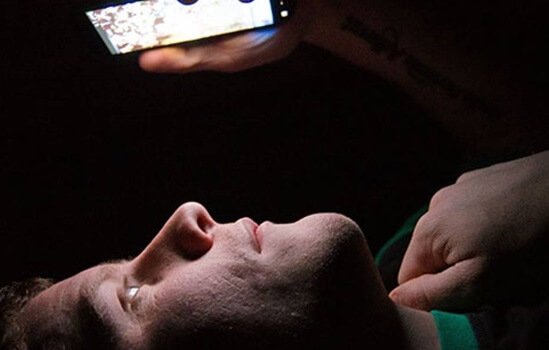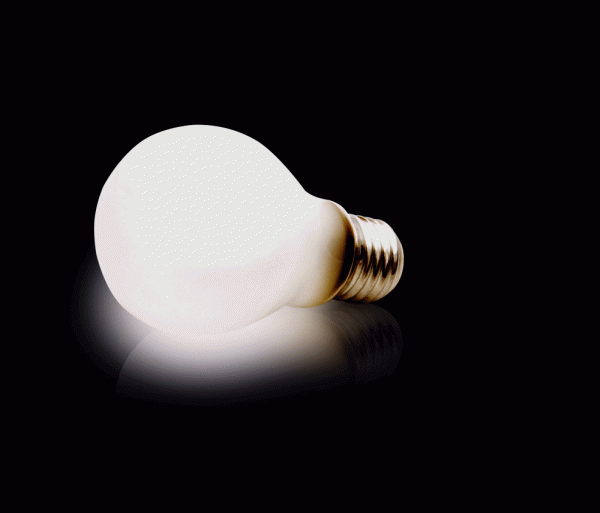Technological Insomnia: Screens That Cause Insomnia


Written and verified by the psychologist Valeria Sabater
Technological insomnia is becoming more of a problem in a world where we’re surrounded by screens. Technology and the blue light characteristic of these devices completely alter our sleep cycles and our biological clocks. This new disorder can cause significant problems. It has become very common in children and adolescents.
Most of us take a last look at our phones before going to bed. We start reading our messages. One message has a link, which takes us to a video. After that, we check our social media, then see an article, then another video. Almost without noticing it, an hour or more has passed.
Cell phones, as well as computers and TVs, are ways to entertain ourselves before going to sleep. We think that this helps us relax before bed. However, in reality, the impact of these screens on our brains is enormous.
It can be somewhat complicated to associate insomnia with this common behavior. Can looking at my phone or computer for a minute before bed really affect my sleep? The answer is simple: yes. An action repeated day after day becomes a habit. When our habit is putting an artificial light in our eyes repeatedly, our brain suffers.
According to a study published in LiveScience, this light stimuli completely alters our circadian rhythm. Moreover, researchers discovered that we currently sleep two hours less a night than people did 40 years ago. These changes mostly affect children and adolescents. What all this means is that we’re seeing the early onset of chronic insomnia. We’re also seeing effects on behavioral, motivational, and academic levels.

What is technological insomnia?
Before we immersed ourselves in the technological world, our bodies were synchronized with sunrise and sunset. During those centuries, people used candles, chandeliers, fireplaces, oil, or gas lamps for light. Those people’s brains greatly appreciated those natural light sources.
Our brains function well when we rise with the sun and go to sleep when it’s dark. When our retinas detect that night is falling, the pineal gland is stimulated to produce melatonin. In this case, the hormone also remains much longer in the bloodstream, which allows humans to sleep better and longer.
Now cities are incredibly bright. Night falls and there’s a new dawn of neon lights, LED lights, buildings lit up like fireworks, and streets that refuse to sleep. We also light up our homes, sometimes late into the night. Screens illuminate our homes. Our cell phones are our lamps. They’re our “magic” link to the world. This means we’re always connected, informed… and over-stimulated.

Effects of screens on our brain
- The artificial light stimuli of cell phones and computer screens on our eyes directly impacts the pineal gland. And what is the result? It interrupts the production of melatonin.
- Blue light inhibits the release of melatonin. Our brain essentially has become unable to detect that it’s nighttime.
- It’s very common for us to use our cell phone, computer, or tablet with the light off. However, this causes serious changes to our brain function. We become overly-stimulated and our brain enters an “alert” state.
- On average, once we stop using our devices, it will take us about one to two hours to fall asleep.
- The time it takes to fall asleep, added to how much longer we stay up on our phones, deprives our body and brain of 7-8 hours of sleep they need to function properly the next day.
- Technological insomnia is also really common among teens between the ages of 14 to 16 years. In addition to causing chronic insomnia, it can also cause overtiredness, difficulty concentrating, poor school performance, headaches, bad moods, etc.
How to treat technological insomnia
Specialists in sleep hygiene state that technological insomnia will grow considerably in the coming decades. Children, for example, have an increasingly early access to devices and it’s very common for children to go to bed without family supervision.
The easy answer is to take away all tablets, cell phones, and computers. This, however, is not realistic. Instead, we need greater awareness, better habits, and other resources. For example, the technology industry is working increasingly on trying to reduce the impact of blue light on our eyes and brains. This means that it comes down to a question of combining healthy habits while also changing the devices themselves.
Let’s take a look at how we can reduce the impact of technological insomnia in our day-to-day lives.
- Dim the light on your screens as night approaches. Both computers and cell phones now have a “night light” option to reduce the impact of blue light.
- You can also buy glasses that filter blue light. These glasses reduce the spectrum of light to help the pineal gland begin to produce melatonin.
- Once it’s dark outside, we should use dimmer lights and lamps. LED bulbs, although more efficient, stimulate our brains more. This is something we want to avoid at nighttime.

Technological insomnia is a growing problem. It’s important to remember the importance of sleep hygiene both in children and adults. The ideal method for avoiding this problem is to turn off all technological devices two hours before bedtime. A good book, a cup of tea with honey, and a good conversation are much more likely to lead to a night of restful, deep sleep.
Technological insomnia is becoming more of a problem in a world where we’re surrounded by screens. Technology and the blue light characteristic of these devices completely alter our sleep cycles and our biological clocks. This new disorder can cause significant problems. It has become very common in children and adolescents.
Most of us take a last look at our phones before going to bed. We start reading our messages. One message has a link, which takes us to a video. After that, we check our social media, then see an article, then another video. Almost without noticing it, an hour or more has passed.
Cell phones, as well as computers and TVs, are ways to entertain ourselves before going to sleep. We think that this helps us relax before bed. However, in reality, the impact of these screens on our brains is enormous.
It can be somewhat complicated to associate insomnia with this common behavior. Can looking at my phone or computer for a minute before bed really affect my sleep? The answer is simple: yes. An action repeated day after day becomes a habit. When our habit is putting an artificial light in our eyes repeatedly, our brain suffers.
According to a study published in LiveScience, this light stimuli completely alters our circadian rhythm. Moreover, researchers discovered that we currently sleep two hours less a night than people did 40 years ago. These changes mostly affect children and adolescents. What all this means is that we’re seeing the early onset of chronic insomnia. We’re also seeing effects on behavioral, motivational, and academic levels.

What is technological insomnia?
Before we immersed ourselves in the technological world, our bodies were synchronized with sunrise and sunset. During those centuries, people used candles, chandeliers, fireplaces, oil, or gas lamps for light. Those people’s brains greatly appreciated those natural light sources.
Our brains function well when we rise with the sun and go to sleep when it’s dark. When our retinas detect that night is falling, the pineal gland is stimulated to produce melatonin. In this case, the hormone also remains much longer in the bloodstream, which allows humans to sleep better and longer.
Now cities are incredibly bright. Night falls and there’s a new dawn of neon lights, LED lights, buildings lit up like fireworks, and streets that refuse to sleep. We also light up our homes, sometimes late into the night. Screens illuminate our homes. Our cell phones are our lamps. They’re our “magic” link to the world. This means we’re always connected, informed… and over-stimulated.

Effects of screens on our brain
- The artificial light stimuli of cell phones and computer screens on our eyes directly impacts the pineal gland. And what is the result? It interrupts the production of melatonin.
- Blue light inhibits the release of melatonin. Our brain essentially has become unable to detect that it’s nighttime.
- It’s very common for us to use our cell phone, computer, or tablet with the light off. However, this causes serious changes to our brain function. We become overly-stimulated and our brain enters an “alert” state.
- On average, once we stop using our devices, it will take us about one to two hours to fall asleep.
- The time it takes to fall asleep, added to how much longer we stay up on our phones, deprives our body and brain of 7-8 hours of sleep they need to function properly the next day.
- Technological insomnia is also really common among teens between the ages of 14 to 16 years. In addition to causing chronic insomnia, it can also cause overtiredness, difficulty concentrating, poor school performance, headaches, bad moods, etc.
How to treat technological insomnia
Specialists in sleep hygiene state that technological insomnia will grow considerably in the coming decades. Children, for example, have an increasingly early access to devices and it’s very common for children to go to bed without family supervision.
The easy answer is to take away all tablets, cell phones, and computers. This, however, is not realistic. Instead, we need greater awareness, better habits, and other resources. For example, the technology industry is working increasingly on trying to reduce the impact of blue light on our eyes and brains. This means that it comes down to a question of combining healthy habits while also changing the devices themselves.
Let’s take a look at how we can reduce the impact of technological insomnia in our day-to-day lives.
- Dim the light on your screens as night approaches. Both computers and cell phones now have a “night light” option to reduce the impact of blue light.
- You can also buy glasses that filter blue light. These glasses reduce the spectrum of light to help the pineal gland begin to produce melatonin.
- Once it’s dark outside, we should use dimmer lights and lamps. LED bulbs, although more efficient, stimulate our brains more. This is something we want to avoid at nighttime.

Technological insomnia is a growing problem. It’s important to remember the importance of sleep hygiene both in children and adults. The ideal method for avoiding this problem is to turn off all technological devices two hours before bedtime. A good book, a cup of tea with honey, and a good conversation are much more likely to lead to a night of restful, deep sleep.
This text is provided for informational purposes only and does not replace consultation with a professional. If in doubt, consult your specialist.







